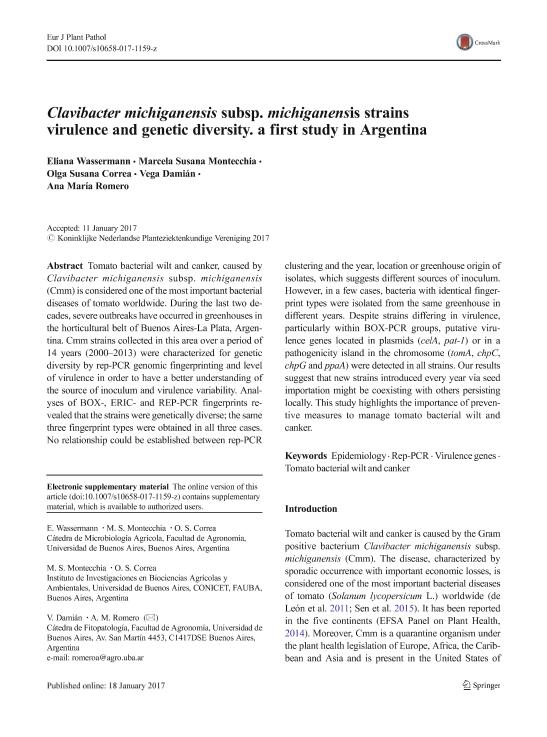Artículo
Clavibacter michiganensis subsp. michiganensis strains virulence and genetic diversity. a first study in Argentina
Wassermann, Eliana ; Montecchia, Marcela Susana
; Montecchia, Marcela Susana ; Correa, Olga Susana; Vega, Damián; Romero, Ana María
; Correa, Olga Susana; Vega, Damián; Romero, Ana María
 ; Montecchia, Marcela Susana
; Montecchia, Marcela Susana ; Correa, Olga Susana; Vega, Damián; Romero, Ana María
; Correa, Olga Susana; Vega, Damián; Romero, Ana María
Fecha de publicación:
09/2017
Editorial:
Springer
Revista:
European Journal of Plant Pathology
ISSN:
0929-1873
e-ISSN:
1573-8469
Idioma:
Inglés
Tipo de recurso:
Artículo publicado
Resumen
Tomato bacterial wilt and canker, caused by Clavibacter michiganensis subsp. michiganensis (Cmm) is considered one of the most important bacterial diseases of tomato worldwide. During the last two decades, severe outbreaks have occurred in greenhouses in the horticultural belt of Buenos Aires-La Plata, Argentina. Cmm strains collected in this area over a period of 14 years (2000–2013) were characterized for genetic diversity by rep-PCR genomic fingerprinting and level of virulence in order to have a better understanding of the source of inoculum and virulence variability. Analyses of BOX-, ERIC- and REP-PCR fingerprints revealed that the strains were genetically diverse; the same three fingerprint types were obtained in all three cases. No relationship could be established between rep-PCR clustering and the year, location or greenhouse origin of isolates, which suggests different sources of inoculum. However, in a few cases, bacteria with identical fingerprint types were isolated from the same greenhouse in different years. Despite strains differing in virulence, particularly within BOX-PCR groups, putative virulence genes located in plasmids (celA, pat-1) or in a pathogenicity island in the chromosome (tomA, chpC, chpG and ppaA) were detected in all strains. Our results suggest that new strains introduced every year via seed importation might be coexisting with others persisting locally. This study highlights the importance of preventive measures to manage tomato bacterial wilt and canker.
Palabras clave:
Epidemiology
,
Rep-Pcr
,
Tomato Bacterial Wilt And Canker
,
Virulence Genes
Archivos asociados
Licencia
Identificadores
Colecciones
Articulos(OCA PQUE. CENTENARIO)
Articulos de OFICINA DE COORDINACION ADMINISTRATIVA PQUE. CENTENARIO
Articulos de OFICINA DE COORDINACION ADMINISTRATIVA PQUE. CENTENARIO
Citación
Wassermann, Eliana; Montecchia, Marcela Susana; Correa, Olga Susana; Vega, Damián; Romero, Ana María; Clavibacter michiganensis subsp. michiganensis strains virulence and genetic diversity. a first study in Argentina; Springer; European Journal of Plant Pathology; 149; 1; 9-2017; 35-42
Compartir
Altmétricas



